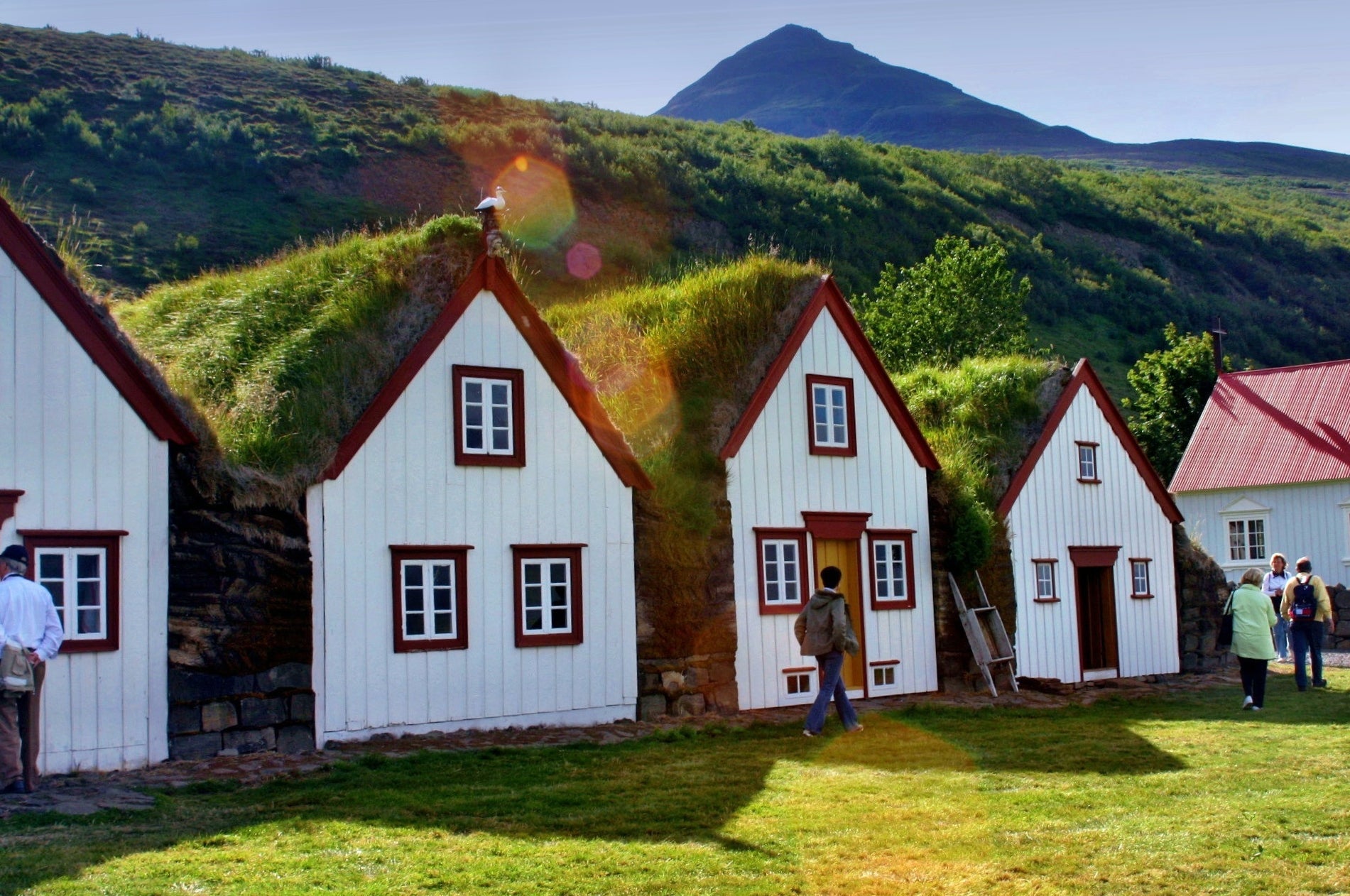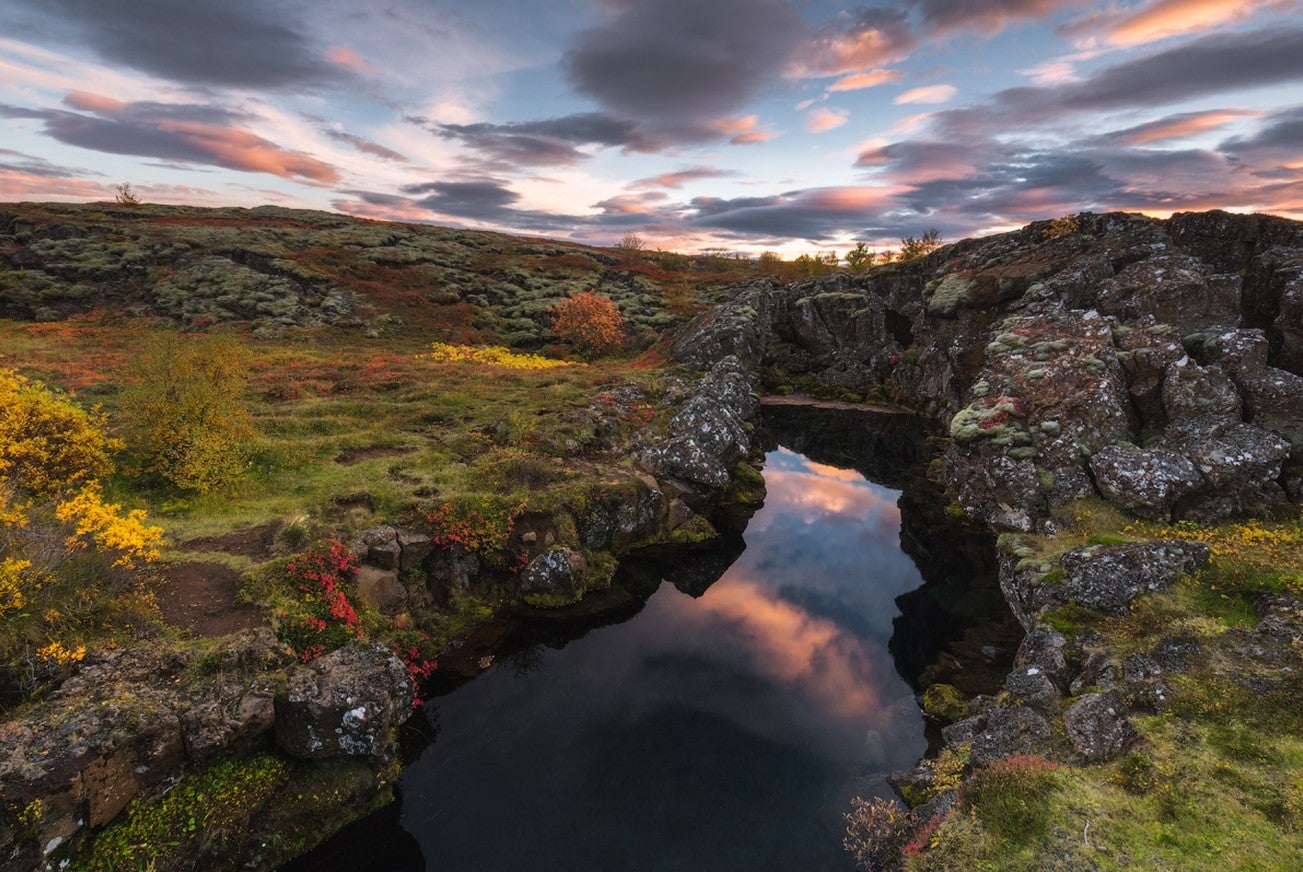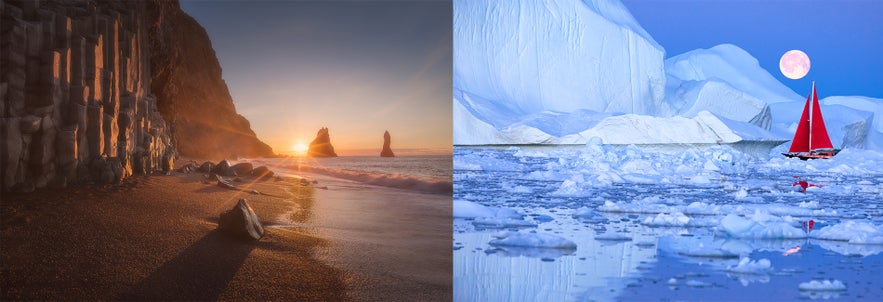
Iceland and Greenland are fascinating countries in the North Atlantic with rich histories, spectacular natural elements, and thriving cultures. Learn how these Nordic countries are similar and what sets them apart.
Iceland and Greenland are neighboring countries in the North Atlantic frequently noticed for the similarity of their names.
Why You Can Trust Our Content
Guide to Iceland is the most trusted travel platform in Iceland, helping millions of visitors each year. All our content is written and reviewed by local experts who are deeply familiar with Iceland. You can count on us for accurate, up-to-date, and trustworthy travel advice.
Situated on the Mid-Atlantic Ridge, Iceland is famous for its geothermal activity and volcanic landscapes. This raw beauty draws visitors eager to explore the country on guided nature tours or by renting a car and setting off on the Ring Road to create their own adventure.
Greenland is the world’s largest island. An expansive ice sheet covers most of the country. With colossal icebergs and a rich Inuit heritage, Greenland is a harsh but beautiful Arctic wonderland.
Keep reading for an in-depth look at the history, nature, and culture of each country.
- See also: The Complete History of Iceland
- See also: Where Is Iceland?
Facts About Iceland and Greenland
-
Iceland and Greenland have overlapping histories and settlement stories involving Norse explorers.
-
Denmark was integral to the development of both countries for centuries and still plays a role in Greenland’s foreign affairs.
-
The story of how each country got its name dates back to Norse Vikings.
-
While similar in many ways, Greenland and Iceland have plenty of differences for tourists to consider when planning a trip.
What’s in a Name?
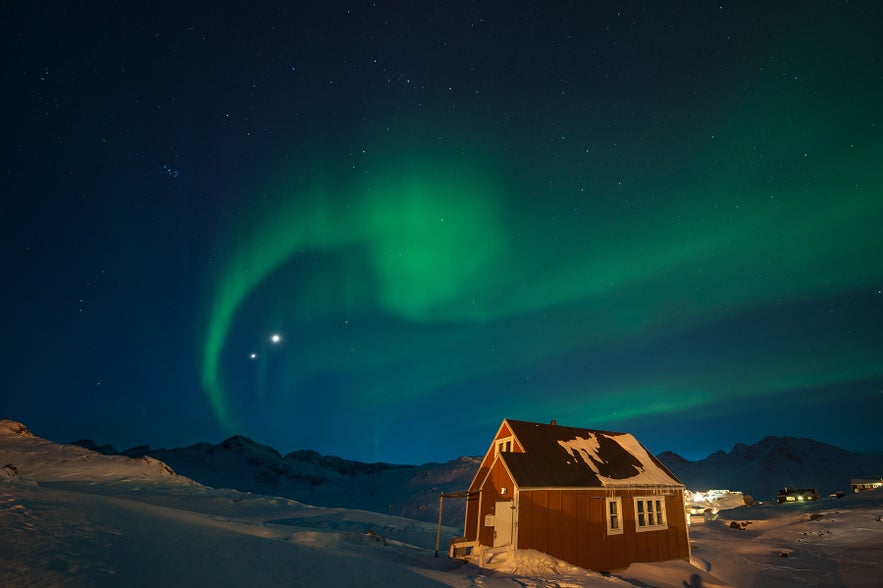
The northern lights in Greenland.
The neighboring countries of Iceland and Greenland often draw attention on the world map due to their somewhat similar names. At a glance, these names might seem strange, suggesting landscapes opposite to their realities. The truth, however, is rooted in an interesting bit of shared history.
A legend surrounding the naming of Greenland and Iceland is that Vikings gave Iceland its name to keep people from settling there and gave Greenland its name to lure people to the island.
The Real Story
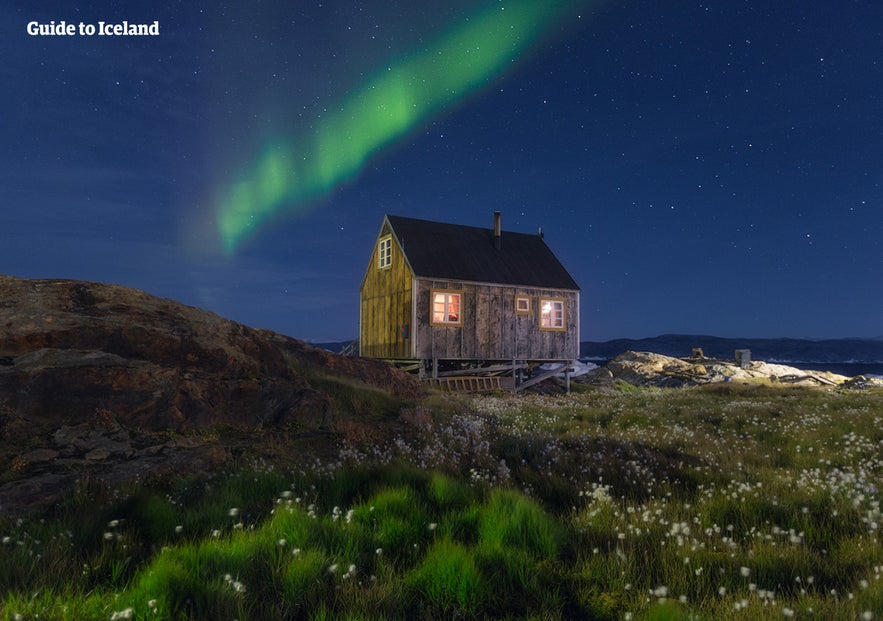
The northern lights in Iceland.
Before Iceland got its name, Gardar Svavarsson, an explorer who stopped there but didn't settle, gave it the name Gardarsholmi (Gardar's Island).
Thankfully, the name didn't stick. Hrafna-Flóki gave Iceland its current name after a rough winter on the new island. He named it Iceland due to the ice he witnessed drifting in the fjords.
The site where Erik the Red settled was likely green at the time, as Greenland's coasts are lush in the summer. There might be some truth to the theory that he gave the land such an inviting name to attract more settlers.
The modern inhabitants of Greenland don’t refer to the country by that name, but they call it "Kalaallit Nunaat," which in the Greenlandic language (Kalaallisut) means "Land of the Kalaallit." Kalaallit is the term for the indigenous Greenlandic Inuits.
The Intertwined Origins of Greenland and Iceland
 There are several connections between the settlement histories of Iceland and Greenland. Classical and medieval manuscripts spoke of a mystical island far in the north called Thule. Historians suggest the location of Thule could’ve been Greenland, Iceland, Norway, or the Shetland Islands of Scotland.
There are several connections between the settlement histories of Iceland and Greenland. Classical and medieval manuscripts spoke of a mystical island far in the north called Thule. Historians suggest the location of Thule could’ve been Greenland, Iceland, Norway, or the Shetland Islands of Scotland.
Iceland Settlement
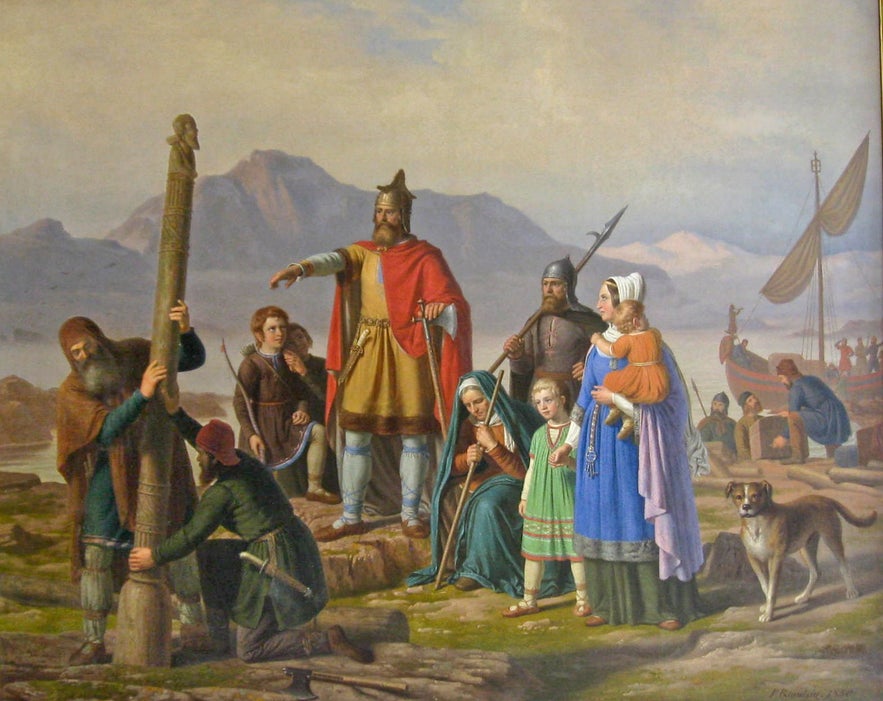
Ingolfur Arnarson settling in Reykjavik.
Flóki Vilgerðarson was among the first men to discover Iceland in the late 9th century. He’s better known by his nickname “Hrafna-Flóki” or "Raven Floki," as he used ravens to aid him on his search for the island. Though he was one of Iceland’s earliest visitors, he decided to leave due to the harsh winter.
The Norwegian-born explorer Ingólfur Arnarson is most often credited as Iceland's first permanent settler. He made his home in modern-day Reykjavik in AD 874.
Greenland Settlement
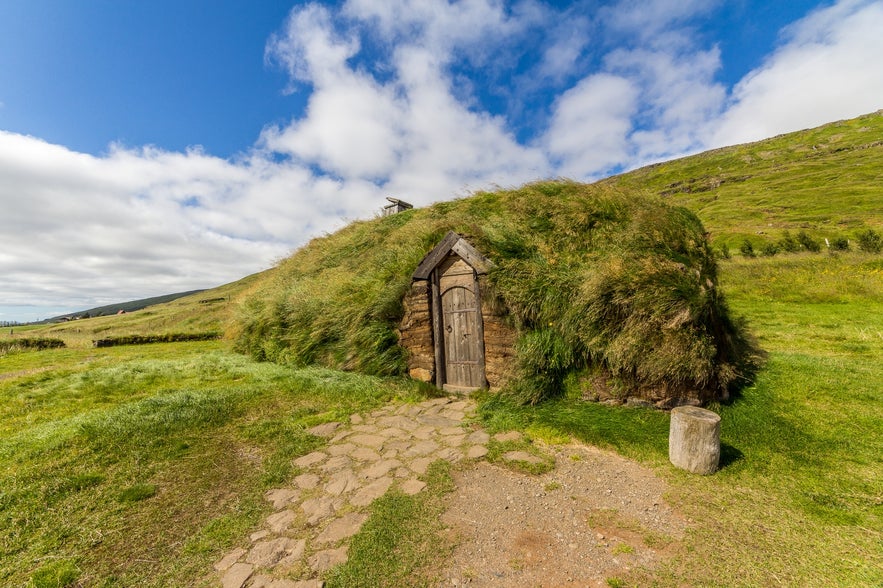
A replica of Erik's homestead in Iceland.
Many settlers who came to Iceland over the next century hailed from Norway. One was Erik the Red. His father, Thorvald Asvaldsson, moved his family to Iceland after being exiled from Norway due to violent disputes. Erik followed in his father's violent footsteps by engaging in bloody conflicts. Like his father, he was exiled from Iceland around AD 982. Today, you can visit the likely site of Erik's homestead, Eiriksstadir, which features a replica of a Viking longhouse.
Erik sailed west to a land unexplored by Norsemen. He spent three years surveying this land and gave it the name Greenland.
Erik returned to Iceland around AD 985 or 986 when his exile ended. He brought tales of Greenland and convinced others to embark on a journey to settle the new land. One of the people who accompanied Erik to Greenland was his son, Leif Erikson, who would later become the first European to set foot on continental North America.
Norse Settlement in Greenland

Ruins from the Norse settlement in Greenland. Image from Wikimedia, Creative Commons, by Number 57.
The Norse established their settlement in Greenland during the Medieval Warm Period (circa AD 950-1250). At the time, temperatures were mild, making agriculture and livestock farming possible.
The settlement established by Erik the Red remained in Greenland before its mysterious disappearance in the 15th century. The reasons behind the colony’s decline remain a mystery.
One potential reason may be a change in living conditions. The climate began to cool around the mid-14th century, a time referred to as the “Little Ice Age.” This change led to shorter growing seasons and harsher winters, which would’ve made farming and livestock management challenging.
Some experts believe the Norse people abandoned the settlement, while others think they perished. Another theory suggests that raiders abducted the Norsemen.
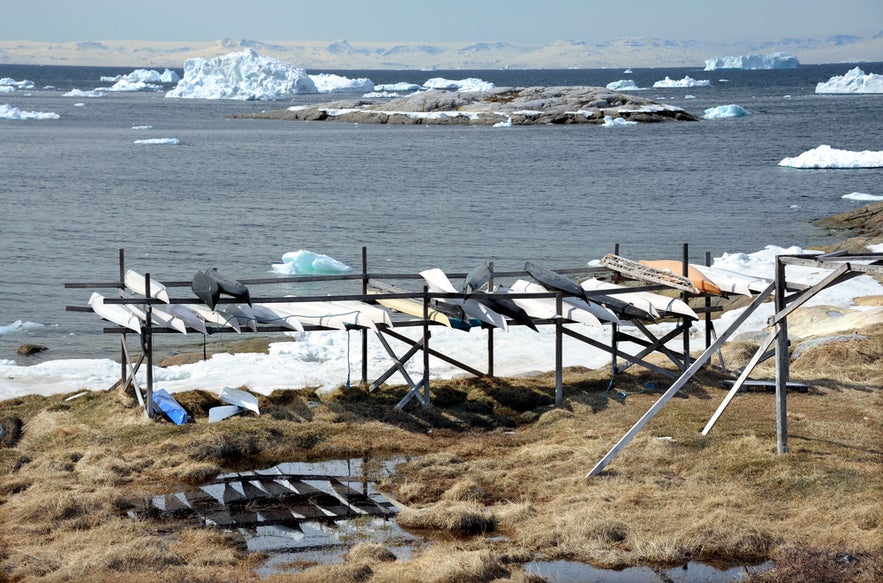 The current Greenlandic population descended from the Thule people. This Inuit culture migrated from modern-day Alaska around AD 1000, reaching Greenland around AD 1300. They adapted well to the environment, using innovations such as dog sleds, toggling harpoons, and kayaks for hunting and whaling.
The current Greenlandic population descended from the Thule people. This Inuit culture migrated from modern-day Alaska around AD 1000, reaching Greenland around AD 1300. They adapted well to the environment, using innovations such as dog sleds, toggling harpoons, and kayaks for hunting and whaling.
While the Thule people moved into Greenland after the Norse had established settlements, there was little evidence of direct contact between the two groups. It's believed that any interaction would’ve been in the form of trade.
Denmark’s Role in Icelandic and Greenlandic History
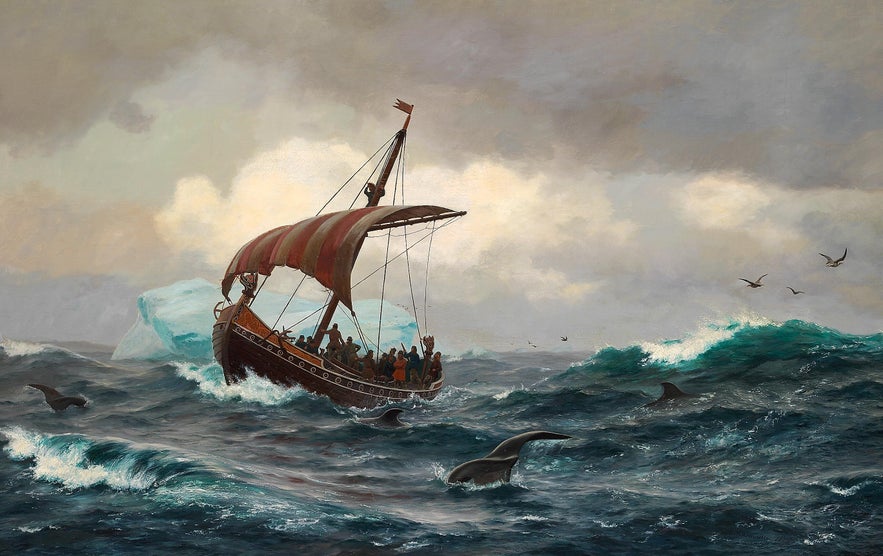
For centuries, Denmark has had a close relationship with Iceland and Greenland. Through colonial rule, trade, political shifts, and war, Denmark had a significant influence on the histories of both countries.
-
AD 930 – Icelandic chieftains established the Althingi at Thingvellir, creating one of the world’s oldest parliaments. Iceland had no central government; regional chieftains governed independently.
-
1262–1264 – Facing internal conflict and pressure, Iceland’s leaders signed the Old Covenant (Gamli ssttmali), bringing the country under the Norwegian crown in exchange for stability and trade access. Around this time, Greenland's Norse settlements also became part of Norway.
-
1397 – With the formation of the Kalmar Union, Norway, Denmark, and Sweden came under a single monarch. Iceland and Greenland, as Norwegian territories, were now indirectly ruled by Denmark through the union.
-
Early 16th century onward – As the Kalmar Union declined, Denmark emerged as the dominant power. Iceland and Greenland, still tied to Norway, were gradually absorbed into Danish rule, particularly after the Denmark–Norway union solidified in the 16th and 17th centuries.
-
1874 – Denmark granted Iceland a constitution, marking the start of its path toward independence.
-
1904 – Iceland gained home rule with its first minister handling domestic affairs, though it remained under Danish sovereignty.
-
1918 – Iceland became a sovereign kingdom in a personal union with Denmark, sharing a monarch but handling most internal matters.
-
1944 – Iceland declared full independence and became a republic during World War II, while Denmark was occupied by Germany.
-
Post-WWII – Denmark modernized its administration in Greenland, integrating it more closely as a Danish county rather than a colonial possession.
-
1979 – Greenland achieved home rule, giving it control over most internal matters such as education and health.
-
2009 – With the Self-Government Act, Greenland took on expanded powers, including control over natural resources, though Denmark retained authority over foreign affairs.
While Denmark played a vital role in shaping the histories of both countries, Iceland and Greenland are both fiercely independent today.
Iceland vs. Greenland: A Modern-Day Comparison

With a shared history of Danish rule, Iceland and Greenland have plenty in common. Many of their traditions stem from the same Nordic roots. For example, much of the old architecture is similar. The countries also have many cultural distinctions that set them apart.
Political and economic relations between Iceland and Greenland have strengthened in recent years. The Icelandic government opened an embassy in Greenland in 2013, and the Greenlandic government did the same in Iceland in 2018.
Language and Population
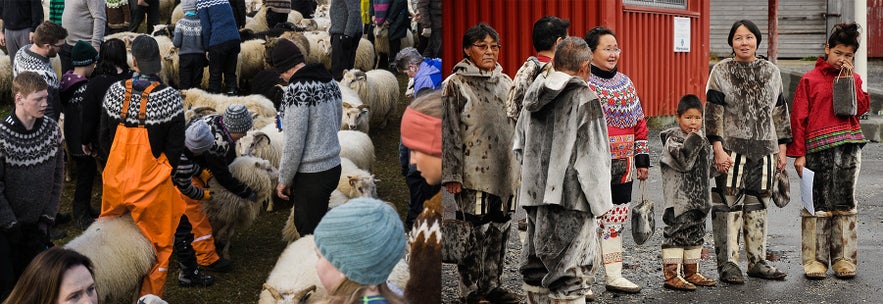
Iceland has a population of about 397,000 people. The official language is Icelandic, which has strong roots in Old Norse, the language spoken by the early Norse settlers. The Icelandic language has changed so little that modern Icelanders can read Old Norse literature fairly well.
The population of Greenland is significantly lower, at around 55,000. The official language is Kalaallisut, an Eskaleut language often referred to as “Greenlandic.” It’s closely related to Inuit languages of Canada, such as Inuktitut.
Before 2009, the official language in Greenland was Danish. The government changed it to strengthen the position of Greenlandic heritage.
Politics of Greenland and Iceland

Iceland is a sovereign republic with a parliamentary system of government. While not part of the European Union, it’s a member of various international organizations, including the United Nations, NATO, the European Free Trade Association, and the Schengen Area.
Greenland is an autonomous territory within the Kingdom of Denmark. It has a significant degree of self-rule, but Denmark handles certain responsibilities such as foreign affairs and defense.
Which Country Would You Visit?

Deciding whether to visit Iceland or Greenland largely depends on what kind of experience you’re seeking. While both countries offer stunning landscapes and unique cultural experiences, there are many differences.
Cost and Accessibility
 Traveling in both countries is expensive, but Greenland often has higher costs due to its remote location. It has a limited infrastructure that lacks a national road system connecting its towns and settlements. Visitors must pay more to travel by plane, helicopter, or boat.
Traveling in both countries is expensive, but Greenland often has higher costs due to its remote location. It has a limited infrastructure that lacks a national road system connecting its towns and settlements. Visitors must pay more to travel by plane, helicopter, or boat.
Iceland has a well-developed tourism infrastructure, including accommodations, tours, restaurants, and roads. There are more international flights to Iceland from North America and Europe than to Greenland, making flying to Iceland much more affordable. It’s also easier to take self-drive tours, which is difficult in Greenland.
Natural Wonders
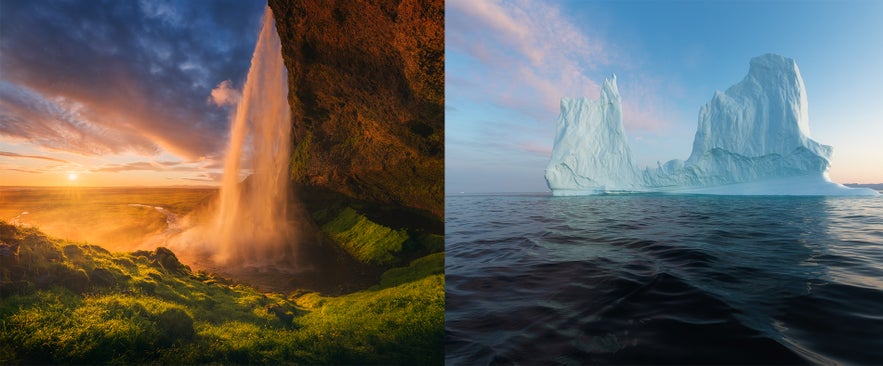
It's easy to see why Iceland is such a popular tourist destination. Sights such as the enchanting Jokulsarlon Glacier Lagoon and the winding shapes of Fjadrargljufur Canyon attract visitors year-round.
The country offers fantastic volcano tours that allow you to see the impact of volcanic eruptions on the environment. There are also plenty of geothermal spas, such as the famous Blue Lagoon, that offer you a chance to relax and rejuvenate after a long trip.
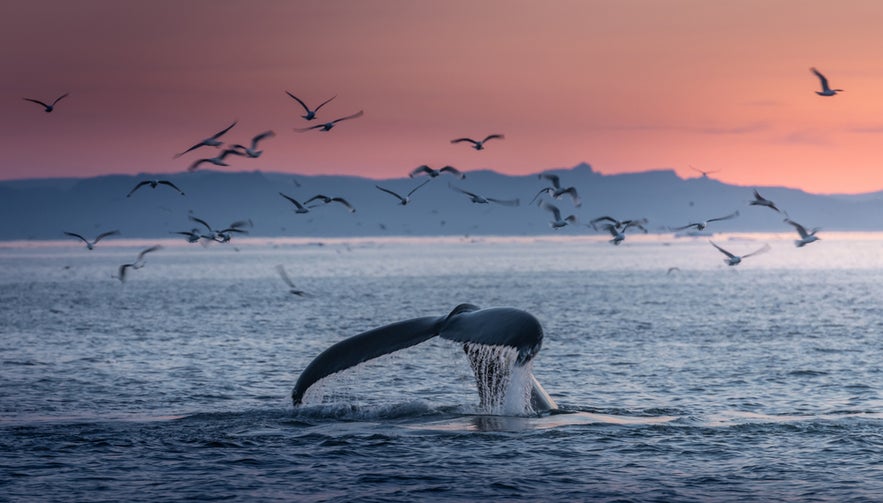 Greenland is also full of astonishing landscapes and natural wonders. Boat excursions to the mouth of the Ilulissat Icefjord and soaking in the Uunartoq Hot Springs make for an unforgettable trip. Travelers can also try dog sledding over the frozen landscape or kayaking in the Arctic waters.
Greenland is also full of astonishing landscapes and natural wonders. Boat excursions to the mouth of the Ilulissat Icefjord and soaking in the Uunartoq Hot Springs make for an unforgettable trip. Travelers can also try dog sledding over the frozen landscape or kayaking in the Arctic waters.
This 8-hour Greenland tour offers a taste of Greenland’s sites including ice caving and iceberg cruising.
Iceland and Greenland are both great locations to see the northern lights. If this is on your bucket list, make sure you go during the winter, as the northern lights are not visible in the summer due to the nearly 24-hour midnight sun.
Weather and Climate
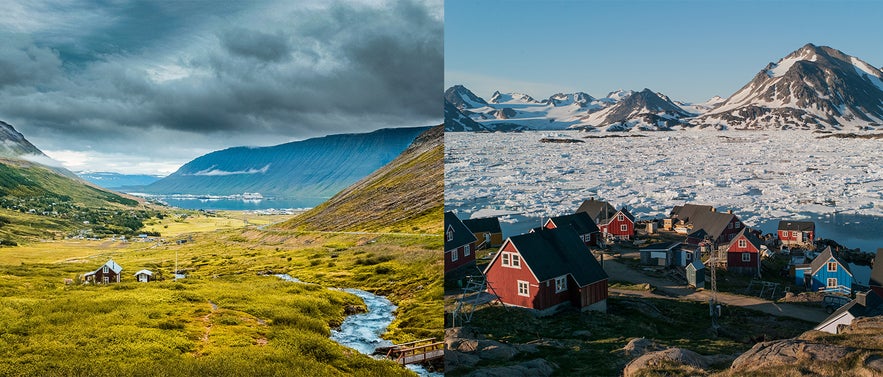
Greenland and Iceland have cold climates typical of northern latitudes. Iceland is generally milder and more temperate, especially in the coastal regions. Winters in Reykjavik are mild compared to other Arctic regions. Summers are cool and can be unpredictable.
Greenland encompasses several climate zones. Coastal regions can have summer temperatures ranging from 41°F to 50°F (5°C to 10°C). Temperatures drop considerably in the winter, often plunging well below freezing. Interior regions stay extremely cold year-round.
Nature and Wildlife

The Arctic fox is Iceland's only native mammal. In recent centuries, newcomers such as reindeer and minks have been introduced. The country is home to many species of birds, including the famous Atlantic puffin.
Iceland's vegetation is mainly grassland with flowers and herbs. Few native trees exist, but afforestation efforts are underway. Mosses and lichens are common, especially in lava fields.
Given its colder and harsher climate, Greenland's vegetation is primarily Arctic tundra with dwarf shrubs, grasses, mosses, and lichens. The southernmost regions have patches of boreal forest with trees such as willow and birch. Greenland is home to magnificent animals such as musk oxen and polar bears.
Whale-watching is a common tourist attraction in both countries. Guided whale-watching tours give visitors the chance to see several different species, including humpback whales, minke whales, orcas, and fin whales.
Planning Your Trip: Iceland and Greenland Tours
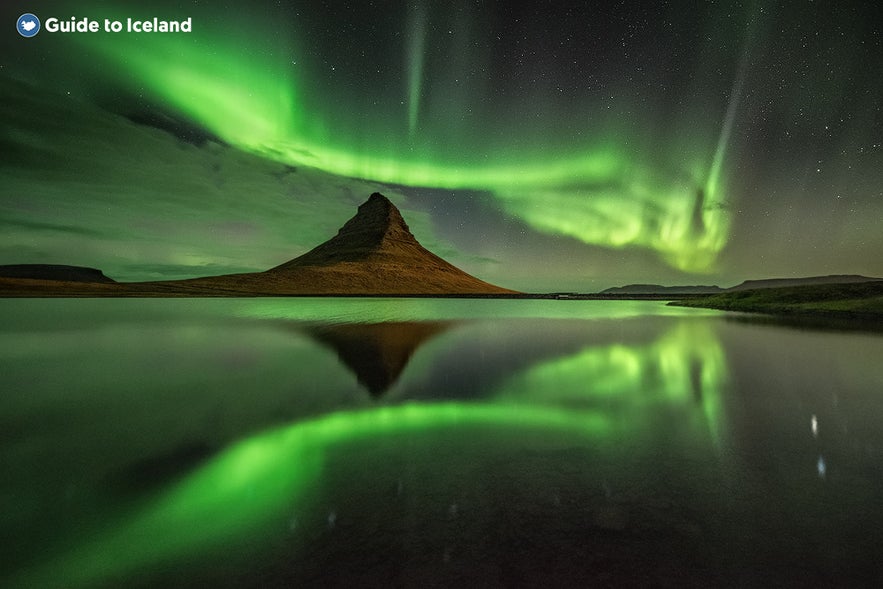
Mount Kirkjufell in Iceland.
Iceland and Greenland are both fantastic travel destinations in their own right, with charming atmospheres, strong cultural heritage, and majestic landscapes. More people choose Iceland for its tourist-friendly atmosphere, accessible attractions, and affordability.
If you’ve decided to travel to Iceland, consider the popular tours below, and hop over to Greenland for a day or two.
-
8-Day Summer Package Featuring Iceland and Guided Greenland Day Tour — Check out some of the most popular Icelandic natural attractions and spend a day in Kulusuk, Greenland.
-
5-Day Summer Package of the Golden Circle, South of Iceland With a Greenland Day Tour — See Iceland’s stunning Golden Circle and South Coast, then fly to Kulusuk for a scenic day in East Greenland.
-
6-Day Summer Vacation Package in South Iceland With a Guided Greenland Day Tour — Combine time in both Iceland and Greenland with this unique two-country adventure across volcanoes, glaciers, and Arctic landscapes.
-
7-Day Summer Package of Iceland & Greenland — Explore Iceland’s south and west, including Jokulsarlon and the Golden Circle, and take a day trip to Kulusuk in Greenland.
-
10-Day Greenland Sailing Trip & Photography Workshop — Sail through Greenland’s remote fjords and photograph dramatic icebergs and Arctic scenery on this multi-day expedition.
FAQs About Greenland Iceland Differences
Have questions about the differences between Iceland and Greenland? We've compiled a list of frequently asked questions to help you better understand these two unique Nordic destinations and plan your trip.
Is English spoken in Iceland and Greenland?
English is widely spoken in Iceland. You can expect most locals, especially the younger generations, to have a near-native proficiency. While some Greenlanders speak English well, their proficiency might not be as high as in Iceland.
Which country has better northern lights?
Both are great, but Iceland is more accessible. There are many tours, which makes seeing the northern lights easier from September to April. Greenland has less light pollution, which is great for viewing the northern lights. However, it’s often hard to reach viewing destinations.
Can you see icebergs in both countries?
Yes, but Greenland is famous for them. The Ilulissat Icefjord is one of the world’s best hotspots. Some of the icebergs are the size of buildings.
Which country is better for food tourism?
Iceland has more international options, and the Reykjavik food scene is diverse. Both countries offer visitors a chance to try traditional cuisine. In Iceland, this includes fermented shark, lamb soup, and skyr. In Greenland, you can try musk ox, reindeer, and whale blubber.
Can you swim in the ocean in both countries?
Technically, yes, but the ocean is freezing year-round. Only Iceland has warm geothermal beaches, which makes swimming more enjoyable for visitors and locals.
Do Iceland and Greenland use the same currency?
No. Each country uses a different currency. Iceland uses the krona (ISK), and Greenland uses the Danish krone (DKK). Credit cards are widely accepted in both countries.
Are earthquakes common in either country?
Iceland sits on the Mid-Atlantic Ridge, causing daily earthquakes. Don’t worry—most are too small to even notice. Greenland has almost no earthquakes because it’s on a stable landmass.
Which country has more daylight in winter?
Iceland has a bit more daylight in winter. The days are short, but there’s never 24-hour darkness. Northern Greenland has months of total darkness in winter.
Which country is safer to visit?
Both are extremely safe. Iceland is one of the safest countries in the world. It has a low crime rate and a high tourism safety record. Greenland is also safe, but remote areas can be dangerous due to weather and wildlife.
Which country has more waterfalls?
Iceland has thousands of waterfalls, many of them well-known. Dettifoss Waterfall is the most powerful in Europe. Greenland has fewer waterfalls due to the icy terrain.
Which To Choose? Why Not Both?
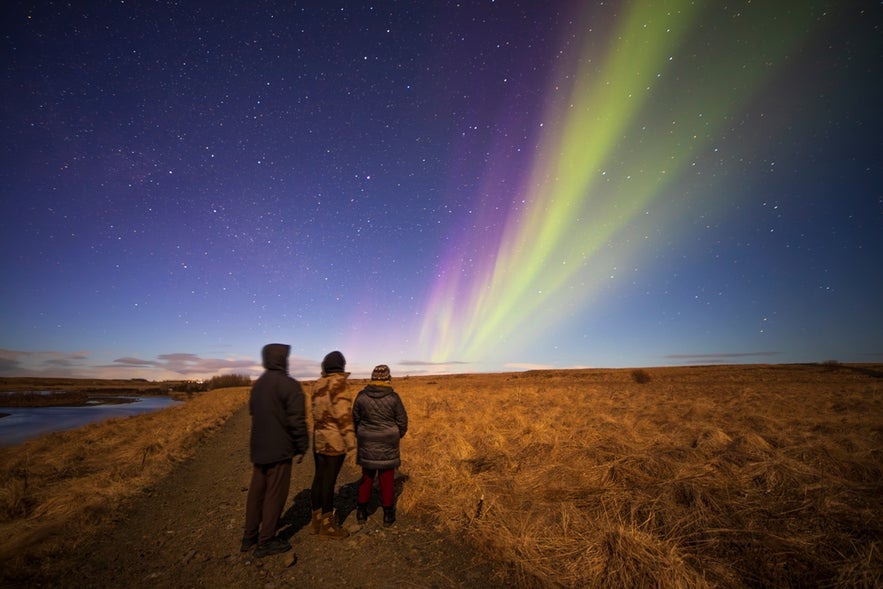 Both Iceland and Greenland offer unparalleled experiences for travelers seeking adventure and natural beauty. Iceland's well-developed tourism infrastructure and diverse landscapes make it a more accessible and popular choice. Greenland's remote Arctic wilderness and unique Inuit culture provide an off-the-beaten-path experience.
Both Iceland and Greenland offer unparalleled experiences for travelers seeking adventure and natural beauty. Iceland's well-developed tourism infrastructure and diverse landscapes make it a more accessible and popular choice. Greenland's remote Arctic wilderness and unique Inuit culture provide an off-the-beaten-path experience.
Whether you're drawn to Iceland’s waterfalls and volcanoes or Greenland’s glaciers and fjords, Iceland and Greenland packages can help you explore the best of both worlds in one unforgettable journey.
Have you decided on Iceland as your next vacation destination? Are you thinking about adding a stop in Greenland? If so, let us know in the comments below!


